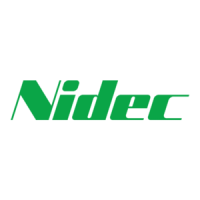What causes bus under voltage during running of Nidec NE200-4T0022G/0040PB DC Drives?
- PPamela BlackwellSep 4, 2025
A bus under voltage during the operation of Nidec DC Drives is caused by power grid low voltage, so check the input power source.

What causes bus under voltage during running of Nidec NE200-4T0022G/0040PB DC Drives?
A bus under voltage during the operation of Nidec DC Drives is caused by power grid low voltage, so check the input power source.
What to do if Nidec DC Drives show ground fault?
If your Nidec DC Drives are indicating a ground fault, it could be due to a short circuit in one of the output phases. Check whether the electric motor insulation is weakening. Also, check whether the wiring between the frequency converter and the electric motor is damaged.
What to do if Nidec NE200-4T0022G/0040PB DC Drives show load short-circuit?
If your Nidec DC Drives are displaying a load short-circuit error, check whether the electric motor coil is short circuit. If the inverting module IGBT is damaged, ask for the services from manufacturers.
What to do if Nidec DC Drives show output phase loss?
If your Nidec DC Drives are showing an output phase loss, check the U-V-W motor wiring. Also, if there is a serious unbalance in output, check the load.
What to do if Nidec NE200-4T0022G/0040PB show input phase loss?
If your Nidec DC Drives are indicating an input phase loss, it means the input RST has phase loss or imbalance, so check input voltage.
Details of drive model number components and their meanings.
Explanation of the information presented on the product nameplate.
Guidelines for suitable installation environments, avoiding dust, moisture, and hazardous gases.
Diagram illustrating the connection of the drive with power supply and peripheral devices.
Important precautions and guidelines for safe and correct main circuit wiring.
Describes the three-level menu structure for parameter setting and modification.
Parameters specific to Vector Control mode, including speed and current loop adjustments.
Parameters for V/F control, covering V/F curve settings and torque boost.
Parameters for configuring motor characteristics like type, power, current, and resistance for optimal control.
Parameters for PID control, including setup channel, feedback, proportional gain, and integration time.
Parameters for motor overload, voltage, current, and phase loss protections.
Parameters for configuring communication settings like baud rate, parity, and timeout for RS485 and CAN.
Parameters for controlling drive start and stop behavior, including start modes and DC braking.
Parameters for Vector Control, including speed loop, current loop, and torque control settings.
Parameters for V/F control, covering V/F curve settings and torque boost.
Parameters for configuring motor characteristics like type, power, current, and resistance for optimal control.
Configuration of digital input terminals, including function selection for various operations.
Parameters for PID control, including setup channel, feedback, proportional gain, and integration time.
Parameters for motor overload, voltage, current, and phase loss protections.
Parameters for configuring communication settings like baud rate, parity, and timeout for RS485 and CAN.
Lists common faults, their possible causes, and corresponding solutions for troubleshooting.
Provides a table for diagnosing general abnormalities and their countermeasures.










